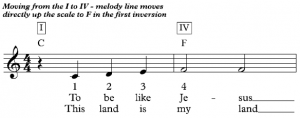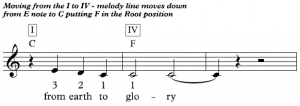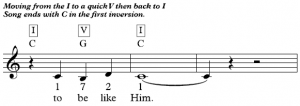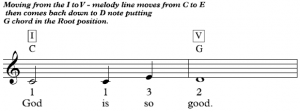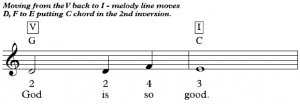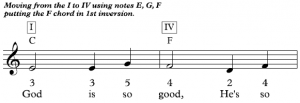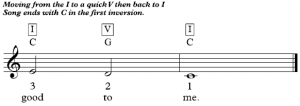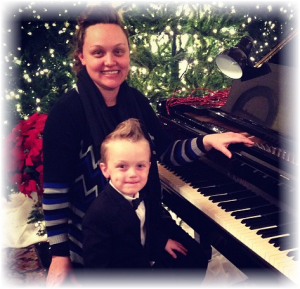We hear a lot of talk about playing by ear, but usually what we’re doing is teaching our students to learn the three basic chord changes of a key signature and then just try to put them into songs until they find where they fit. In this lesson I am going to suggest several things we can actually LISTEN for so we’ll know and not have to guess what chord change is used.
Remember this lesson will cover just the basic changes—the I, IV and V. If you cannot automatically HEAR these movements or are teaching a beginner to hear chord movements, this will be a great foundation!
The examples given are in the key of C so I’m using the C scale (do-re-me-fa-so-la-te-do). It has all white notes and is the easiest key to play. In preparation:
- Get familiar with the C scale. The notes are:
- C – D – E – F – G – A – B – C
Listen to the C scale going UP and coming DOWN
- In the key of C, the basic chord changes are the C (I) chord, the F (IV) chord and the G (V) chord.
- Learn those chords. They are also called triads because they are 3-note chords.
- It is IMPERATIVE to learn chords in 3 positions. These are called the ROOT position, the 1st inversion (to invert means to turn something over—so you’re basically just turning over your chord) and the 2nd inversion. Click here to download the Major Chord Charts.
Listening Clues:
The tonal movement from the C to F goes UP higher or “lifts.”
The tonal movement from the C to G goes DOWN or lower.
In the song “To be like Jesus” on the first line
.you will hear
- The melody moving up the C scale, C, D, E, F You know you are moving from the C chord to the F chord in the 1st inversion.
You also can listen for the bottom end (bass or left hand) to move up the scale C, D, E, F. The numbers under the staves below are scale degrees related to the C scale.
- On the 2nd line “to be like Jesus” you will hear the F moving back to the C chord in the 2nd inversion. You will hear the bottom end of the song move down F, E, D, C and you’ll be back to the C chord.
- “to be like Him” You will hear the C move to the G chord in the Root position.
- The melody notes might move: C E D – when you arrive at the D note you will play the G chord.
- Or the melody might move: C D E D – this will indicate a move to the V change which is the G chord.
- You will be able to hear (at least in your head) the bottom end move down C, B, A G
- “All through life’s journey” The G chord moves back to the C chord in the 1st inversion. Listen for that bass line moving G A B C
- “From earth to glory.” Listen to the bottom end move C, D, E F and you know you’re moving to the F chord.
- “I only ask” goes back to the C chord in the root position.
- “To be” goes to the G chord – listen for the bass end to drop lower
- “Like Him” – comes home to C – song ends with C in the 1st inversion.
Just a quick hint! The 1st two lines of “This Land is Your Land” is pretty much identical to “To Be Like Jesus”
Another thing to remember is that the BASIC chord changes will most likely take place on the DOWNBEAT (beat 1 of the measure) or beat 3.
Now I’m going to play through “To Be Like Jesus” with simple chords.
In the Song “God is So Good”
- 1st “God is so good”. Listen for bottom end to move lower C B A G or the melody line to move C E D and you know you’re moving to the G chord in the Root position.
- 2nd “God is so good” – listen for the bass end to move G, A B C – and you’re coming back to the C chord in the 2nd inversion.
- On the 3rd line “God is good” – listen for the bass end to move C D E F a quick F chord in the 1st inversion.
- “He’s so good” – bass end coming back down to C in the 2nd inversion.
- “To” – bass moving lower to G – notice the melody note is on the D putting the G chord in the Root position.
- Comes back home to C in the first inversion. The melody will move E D C and you’re home!
Now I’m going to play THROUGH “God is So Good” with simple chords.
I hope you have enjoyed this lesson and will share it! Remember this is just the I, IV and V–the foundation chord movements! We’ll catch the moves to the vi and ii later!!!
Be blessed!

